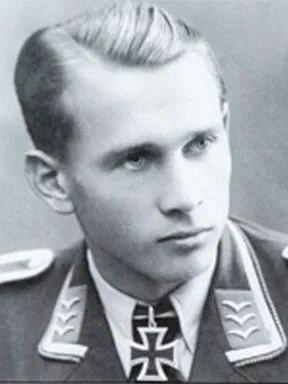
Alfred Grislawski (2 November 1919 – 19 September 2003) was a German former Luftwaffe fighter ace and recipient of the Knight’s Cross of the Iron Cross with Oak Leaves during World War II. A flying ace or fighter ace is a military aviator credited with shooting down five or more enemy aircraft during aerial combat. He was credited with 133 victories claimed in over 800 combat missions. He recorded 24 victories over the Western front, including 18 United States Army Air Forces (USAAF) four–engine bombers. Of his 109 claims recorded over the Eastern front, 16 were Il-2 Sturmoviks.

Military career
Alfred Grislawski was born 2 November 1919 at Wanne-Eickel in the Ruhrgebiet, the son of Gustav Grislawski, a coal miner, and his wife Henriette. He was the second of four children, with an older brother, Walter, a younger sister, Herta, and the youngest brother Horst. On leaving school Grislawski worked on a farm in Pomerania. He applied to join the Navy but was rejected in preference to a posting in Naval Aviation. Grislawski began his training at Fliegerersatzabteilung 16 at Schleswig. In July 1940, the graduated Gefreiter Grislawski was posted into III./Jagdgeschwader 52 (JG 52), based at Zerbst. He was promoted to Unteroffizier in October. The same month III./JG 52 was ordered to Romania and as the redesignated I./JG 28 tasked with training Romanian Air Force personnel. In August 1941, III./JG 52 was ordered to the Eastern Front and based in Ukraine. Grislawski gained his first victory on 1 September 1941, when he shot down a Soviet I-16. By the end of 1941, Grislawski had a victory total 11. At the end of December, III./JG 52 relocated to the Kharkiv area. In April, 9./JG 52 were ordered to the Crimea in support of the Kerch offensive. Grislawski recorded his 20th claim on 30 April, when he shot down a Soviet I-15bis fighter-bomber. Grislawski was particularly successful during May 1942 claiming 22 victories, and in July Grislawski was awarded the Knight’s Cross of the Iron Cross (Ritterkreuz des Eisernen Kreuzes) for 43 victories, and sent on leave on 24 July. In August 1942 Oberfeldwebel Grislawski was assigned to 7./JG 52 based in the Caucasus. In September, he claimed 16 victories over the Terek bridgehead. On 5 November he shot down four Ilyushin Il-2s but was shot down in Bf 109 G-2 and belly-landing with a few bruises. On 18 January 1943, Grislawski’s Rotte was intercepted by Soviet I-16 fighters and Grislawski’s Bf 109 was hit, setting on fire. He nursed his aircraft over German lines before baling out, sustaining facial burns. Grislaski was one of the four pilots in the famed Karaya Quartet.
On 26 January Grislawski received promotion to Leutnant. He recorded his 92nd victory on 3 February 1943. On 27 April 1943 he recorded his 100th victory. In June 1943 he was wounded by blast from a German land mine near Taman. On his recovery Grislawski transferred to Jagdgruppe Süd (JGr Süd). In August 1943 elements of JGr Süd were redesignated Jagdgeschwader 50 (JG 50), under the command of Major Hermann Graf and charged with intercepting the high-flying Royal Air Force de Havilland Mosquito fighter-bomber and photo-reconnaissance aircraft. Based at Wiesbaden-Erbenheim he shot down his first two United States Army Air Forces (USAAF) four-engine bombers on 17 August. In early October Grislawski was promoted to the rank of Hauptmann and given temporary command of JGr. 50. In November 1943 Grislawski was appointed Staffelkapitän of 1./JG 1 based at Deelen, flying the Fw-190. He was shot down by USAAF bombers over Baske on 24 January 1944 and wounded, bailing out of his Fw 190A-7. Grislawski was then posted as Staffelkapitän of 8./Jagdgeschwader 1 (JG 1) on 13 March 1944. Operating the new Bf 109 G-6/AS especially equipped for high-altitude operations, the unit was tasked with combating the potent USAAF fighter escorts.
Hauptmann Grislawski was awarded the Knight’s Cross of the Iron Cross with Oak Leaves (Ritterkreuz des Eisernen Kreuzes mit Eichenlaub) on 11 April for 122 victories. Grislawski then led 8./JG 1 to France to combat the Allied landings in Normandy. After less than a week the unit was relocated to Germany having been decimated in operations against the beachhead. In July Grislawski was back to France as acting Gruppenkommandeur of III./JG 1. On 27 July, Grislawski was shot down by Spitfires, baling out safely. At the end of July 1944 Grislawski was transferred to Staffelkapitän of 11./JG 53. He claimed two B-17 four-engine bombers shot down on 12 September. On 26 September 1944, Grislawski was credited with a P-38 twin-engine fighter shot down as his 133rd and last claim. His Bf 109 G-14 was hit in the engine by a P-51 flown by Col. Hubert Zemke and caught fire. He baled out but had a very hard landing that cracked two vertebrae in his back and he spent the remainder of the war in a military hospital. By the end of the war Grislawski was at Badgastein in the Austrian Alps. He was able to cross the zone border and return to his hometown of Wanne-Eickel. He declined to join the Bundesluftwaffe because of his wartime injuries. Grislawski died on 19 September 2003.
Awards
- Ehrenpokal der Luftwaffe (30 May 1942)
- Iron Cross (1939)
- 2nd Class (9 September 1941)
- 1st Class (29 October 1941)
- Front Flying Clasp of the Luftwaffe for Fighter Pilots in Gold (5 December 1941)
- Knight’s Cross of the Iron Cross with Oak Leaves
- Knight’s Cross on 1 July 1942 as Feldwebel and pilot in the 9./JG 52
- 446th Oak Leaves on 11 April 1944 as Hauptmann (war officer) and Staffelkapitän of 1./JG 1